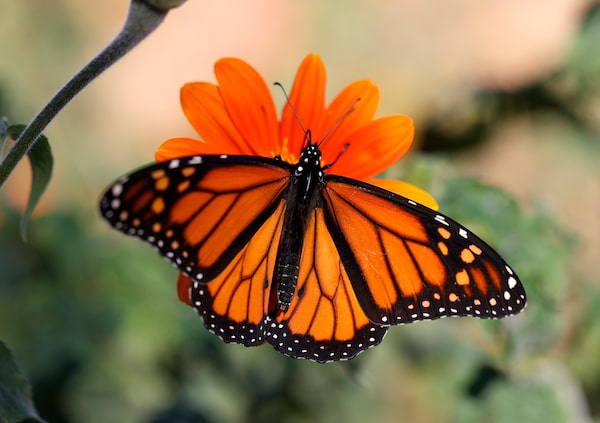
A Monarch butterfly lands on a flower at the Rinconada Community Garden on Nov. 3, 2021 in Palo Alto, Calif.Justin Sullivan/Getty Images
A year after the western monarch butterfly nearly vanished from view in California, the iconic insect has come fluttering back this winter in large numbers, leaving conservationists celebratory – and perplexed.
Late last year, volunteers trekked through poison oak and biting ticks to count nearly a quarter of a million monarchs, documenting large clusters from Pacific Grove to Santa Cruz, Los Angeles and Orange County.
It’s far from the millions that once wintered in California, but a hundred-fold increase from what was counted in 2020, when dramatically low numbers raised serious questions about the continued viability of butterflies that can occasionally migrate from as far north as the Okanagan Valley.
The bounce back this year offers a “rare ray of hope that the population is more resilient than we thought,” said Emma Pelton, a biologist who is western monarch lead for The Xerces Society, a Portland-based conservation group that has co-ordinated the annual count since 1997.
“These butterflies can do some extraordinary things.”
Study suggests neonic pesticides harming monarch butterfly eggs
Monarchs owe their iconic status to their vivid colours but also to their feats of airmanship. Weighing less than a gram, they can migrate thousands of kilometres. Eastern monarchs seek winter warmth in Mexico, where researchers have also documented dramatic declines. In 2020, eastern monarchs occupied 2.1 hectares of their overwintering site, roughly a third of what would be considered sustainable. (That amounts to roughly 45 million butterflies.)
That same year, the western monarch appeared on the brink of extinction. In the fall of 2020, volunteers in California counted just 2,000 monarchs. Chip Taylor, an emeritus scholar of biology at the University of Kansas, had predicted that by 2021, the number would fall to the hundreds.
Instead, 247,237 were counted, the highest since 2016.
“That tells you how much I know. And that tells you how much we all know,” Prof. Taylor said in an interview Tuesday.
What he can say with some confidence is that, mathematically, it is implausible that just 2,000 butterflies increased in number to nearly 250,000.
That suggests some monarchs spent the winter of 2020 elsewhere, where they went uncounted.
In 2020, California set temperature records in October, the typical migration month, and Prof. Taylor, the founder and director of Monarch Watch, speculates that some butterflies stayed in cooler forested mountain areas because the coast was simply too hot.
What “we’re seeing in California is more and more of these extreme weather events. And that’s what’s making it difficult to really understand what’s going on here, because it’s throwing off the dynamics a great deal,” he said.
This year’s return of western monarchs to more typical overwintering areas has coincided with cooler temperatures.
California is, however, one of the country’s fastest warming states – an average increase of 0.7 degrees Fahrenheit in summer temperatures per decade since 1975 – and significant areas of the state are being emptied of moths and butterflies. Beekeepers have been forced to higher elevations to find sufficient nectar for their colonies.
Canada has designated monarchs an endangered species. Conservationists have sought the same in the U.S., but the Fish and Wildlife Service in late 2020 said such a designation, while warranted, is “precluded” by other more important conservation priorities.
Roughly 90 per cent of the world’s monarchs live in North America. The eastern population has fallen to a fraction of its 1996 size of 384 million. In the 1980s, scientists counted millions of western monarchs.
Against that backdrop, the numbers this winter constitute a decline of 95 per cent or more, conservationists say. They fault the U.S. government for doing too little to protect monarchs and blame over-use of herbicides for killing milkweed, the sole food source for their caterpillars.
Still, the return of hundreds of thousands of monarchs this year inspired wonder.
Richard Rachman, a graduate student at California State University, Northridge, co-ordinated the volunteer count for Los Angeles County.
One foggy day, he followed a public tip to a public greenway at Hermosa Beach, just south of Los Angeles International Airport, where he spied orange flourishes garlanding a Torrey pine. He counted 1,400 butterflies.
The author Barbara Kingsolver once described clusters of monarchs as “trembling flame,” and seeing them left Mr. Rachman “quite literally awestruck,” he said.
“They’re hanging out there, and as the wind blows they kind of puff up,” he recalled. His group documented the most monarchs seen in Los Angeles in more than two decades.
“We need to remind our kids that that used to be normal,” he said. “And what we have now is abnormal.”
Our Morning Update and Evening Update newsletters are written by Globe editors, giving you a concise summary of the day’s most important headlines. Sign up today.